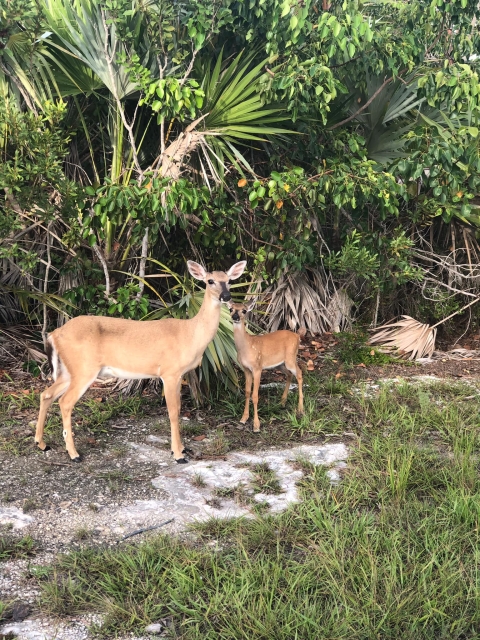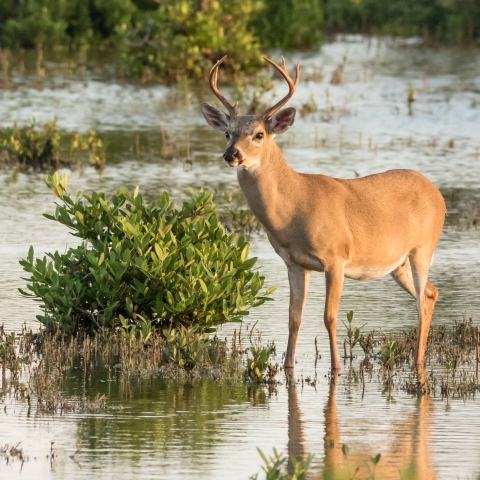Key deer, the smallest subspecies of the North American white-tailed deer, inhabit no other place on Earth besides the lower Florida Keys. First listed as an endangered species under the Endangered Species Preservation Act in 1967, the species receives continued protection as an endangered species under the Endangered Species Act of 1973 (ESA).
Living in areas from the pine forests of the lower Keys to the freshwater wetlands and mangroves, these wonderful animals unique to the Florida Keys travel among these different habitats, walking, wading, and swimming from island to island. Largely plant eaters, they feed on dozens of native plant species with their primary food source being the red mangroves and selections of plant foods that change seasonally.
Key deer once occupied an area extending from Vaca Key to Key West but now reside in just 26 islands from Big Pine Key to Sugarloaf Key. The National Key Deer Refuge and Great White Heron National Wildlife Refuge encompass much of this range. "The Service is committed to providing Key Deer with every opportunity to exist as a healthy, wild population," said Christian Eggleston, Project Leader for the Florida Keys National Wildlife Refuge Complex, which includes the National Key Deer Refuge and Great White Heron Refuges.
Wild animals – urban places
While Key deer live near humans, they remain wild animals. Key deer are not domesticated, captive bred, or 'semi-wild' animals. Wild animals and domesticated animals have different needs when it comes to treatment and care of injury or disease. Wild animals may become stressed in captive situations, resulting in further injury or death. Becoming accustomed to humans in captive settings or rehabilitation settings can further harm wild animals, resulting in an inability to return to wild settings.
The U.S. Fish and Wildlife Service’s mission is to oversee the conservation and recovery of imperiled plant and animal species, like the Key deer. This includes working to ensure wild populations can maintain healthy wild behaviors and adapt to natural processes such as injury, illness, and death - all of which play important roles in long-term evolutionary processes. Key deer have evolved this way for thousands of years, adapting and persisting with the ever-changing conditions of the Florida Keys. At higher population densities, injury and illness are more common. “Overall, the condition of the Key deer herd appears to be healthy and strong,” stated Brian Powell, Key deer Recovery Lead, South Florida Ecological Services Field Office. “Preliminary results from two recent studies of the Key deer population conducted in 2022 and 2023 indicate that Key deer populations have likely reached pre-screw worm and pre-Hurricane Irma levels.”
Reporting sick or injured Key deer
The Florida Fish and Wildlife Conservation Commission Wildlife Hotline, 888-404-3922 (extension 1) is available to report injured, sick, or dead Key deer. After a call is received, the dispatcher sends a law enforcement officer from Florida Fish and Wildlife Conservation Commission, the U.S. Fish and Wildlife Service, or Monroe County Sheriff’s Office to find the injured deer and assess the nature of the injuries. If the deer is responsive, has injuries that appear to be minor, or old and healing, does not show disease symptoms, and is able to move on its own, then the animal is left alone to rest and recover naturally.
If a deer's injuries are such that veterinary care can be provided and the deer can be released back into the wild, law enforcement officers contact a veterinarian who is federally permitted to administer care for Key deer. In severe situations when injuries are deemed serious enough or the deer is not able to move or feed or survive on its own, then the officer is able to make the decision to euthanize the deer to alleviate its suffering. Wildlife veterinarians with the Service are also consulted on certain cases, particularly when disease is suspected.
In addition to training received from their respective agencies, law enforcement officers from Florida Fish and Wildlife Conservation Commission and Monroe County Sheriff’s Office who respond to deer calls have received specific training in Key deer incident response and euthanasia with Service biologists and law enforcement officers. These trainings covered all major aspects of response to Key Deer calls and incorporated the most up to date knowledge and information on Key deer biology and animal welfare.
Keeping the wild in the Key deer
The response to Key deer incidents emphasizes the importance of treating Key deer as wild animals and allowing natural processes to occur. However, particularly if an animal has a human caused injury or condition (such as an entanglement in ropes or foreign objects) that an animal can recover from with a onetime treatment, a higher-level intervention is possible. In these rare cases, animals may be captured, treated, and immediately released by trained personnel.
If you see an injured, sick, or dead deer, you can help by calling Florida Fish and Wildlife Conservation Commission Dispatch at 888-404-3922 (extension 1) and giving the distressed animal plenty of space. Additionally, you can help us keep Key deer healthy and wild by not approaching, touching, or feeding them.
“As a wildlife biologist with many years of experience working in the field with species such as mountain lions, bighorn sheep and now Key deer, I think what I most appreciate and admire about these animals are their amazing wild instincts, as well as their toughness and resilience through the many challenges they face,” said Dr. Jennifer Feltner, Refuge Biologist, Florida Keys National Wildlife Refuge Complex. “That wildness is what allows them to survive and thrive, especially when we humans give them their space.”
Thank you for helping to keep Key deer in the wild and the wild in Key deer!





